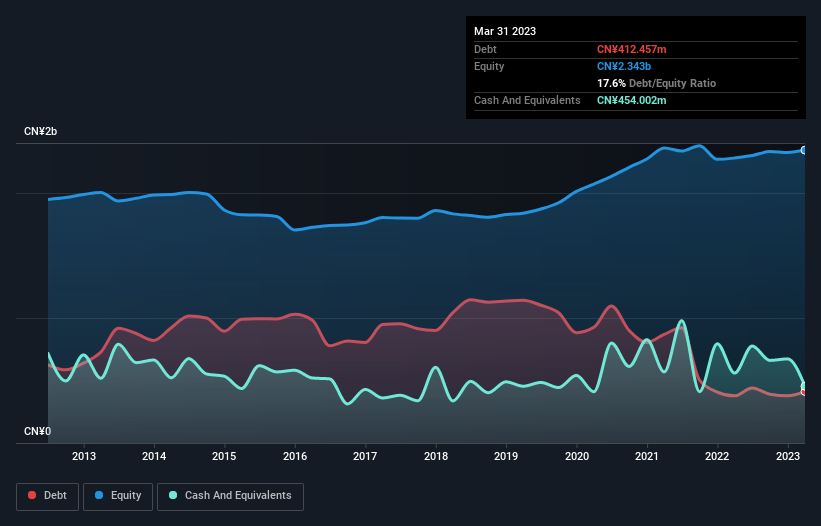
Legendary fund manager Li Lu (who Charlie Munger backed) once said, 'The biggest investment risk is not the volatility of prices, but whether you will suffer a permanent loss of capital.' It's only natural to consider a company's balance sheet when you examine how risky it is, since debt is often involved when a business collapses. Importantly, DaChan Food (Asia) Limited (HKG:3999) does carry debt. But the real question is whether this debt is making the company risky.
When Is Debt Dangerous?
Debt is a tool to help businesses grow, but if a business is incapable of paying off its lenders, then it exists at their mercy. Ultimately, if the company can't fulfill its legal obligations to repay debt, shareholders could walk away with nothing. However, a more common (but still painful) scenario is that it has to raise new equity capital at a low price, thus permanently diluting shareholders. Of course, debt can be an important tool in businesses, particularly capital heavy businesses. When we think about a company's use of debt, we first look at cash and debt together.
See our latest analysis for DaChan Food (Asia)
What Is DaChan Food (Asia)'s Net Debt?
As you can see below, at the end of March 2023, DaChan Food (Asia) had CN¥412.5m of debt, up from CN¥377.2m a year ago. Click the image for more detail. But on the other hand it also has CN¥454.0m in cash, leading to a CN¥41.5m net cash position.

A Look At DaChan Food (Asia)'s Liabilities
According to the last reported balance sheet, DaChan Food (Asia) had liabilities of CN¥850.6m due within 12 months, and liabilities of CN¥321.2m due beyond 12 months. On the other hand, it had cash of CN¥454.0m and CN¥539.3m worth of receivables due within a year. So it has liabilities totalling CN¥178.5m more than its cash and near-term receivables, combined.
DaChan Food (Asia) has a market capitalization of CN¥525.1m, so it could very likely raise cash to ameliorate its balance sheet, if the need arose. However, it is still worthwhile taking a close look at its ability to pay off debt. While it does have liabilities worth noting, DaChan Food (Asia) also has more cash than debt, so we're pretty confident it can manage its debt safely.
In addition to that, we're happy to report that DaChan Food (Asia) has boosted its EBIT by 81%, thus reducing the spectre of future debt repayments. When analysing debt levels, the balance sheet is the obvious place to start. But it is DaChan Food (Asia)'s earnings that will influence how the balance sheet holds up in the future. So if you're keen to discover more about its earnings, it might be worth checking out this graph of its long term earnings trend.
Finally, a business needs free cash flow to pay off debt; accounting profits just don't cut it. While DaChan Food (Asia) has net cash on its balance sheet, it's still worth taking a look at its ability to convert earnings before interest and tax (EBIT) to free cash flow, to help us understand how quickly it is building (or eroding) that cash balance. During the last three years, DaChan Food (Asia) generated free cash flow amounting to a very robust 83% of its EBIT, more than we'd expect. That puts it in a very strong position to pay down debt.
Summing Up
While DaChan Food (Asia) does have more liabilities than liquid assets, it also has net cash of CN¥41.5m. The cherry on top was that in converted 83% of that EBIT to free cash flow, bringing in -CN¥34m. So is DaChan Food (Asia)'s debt a risk? It doesn't seem so to us. The balance sheet is clearly the area to focus on when you are analysing debt. But ultimately, every company can contain risks that exist outside of the balance sheet. Be aware that DaChan Food (Asia) is showing 2 warning signs in our investment analysis , you should know about...
At the end of the day, it's often better to focus on companies that are free from net debt. You can access our special list of such companies (all with a track record of profit growth). It's free.
New: Manage All Your Stock Portfolios in One Place
We've created the ultimate portfolio companion for stock investors, and it's free.
• Connect an unlimited number of Portfolios and see your total in one currency
• Be alerted to new Warning Signs or Risks via email or mobile
• Track the Fair Value of your stocks
Have feedback on this article? Concerned about the content? Get in touch with us directly. Alternatively, email editorial-team (at) simplywallst.com.
This article by Simply Wall St is general in nature. We provide commentary based on historical data and analyst forecasts only using an unbiased methodology and our articles are not intended to be financial advice. It does not constitute a recommendation to buy or sell any stock, and does not take account of your objectives, or your financial situation. We aim to bring you long-term focused analysis driven by fundamental data. Note that our analysis may not factor in the latest price-sensitive company announcements or qualitative material. Simply Wall St has no position in any stocks mentioned.
About SEHK:3999
DaChan Food (Asia)
Manufactures and sells livestock feeds, poultry and chilled meats, and processed foods in the People’s Republic of China, Japan, and rest of the Asia Pacific.
Flawless balance sheet low.
Market Insights
Community Narratives




